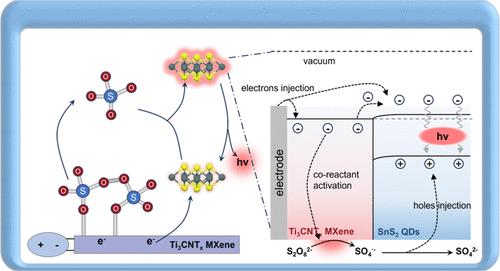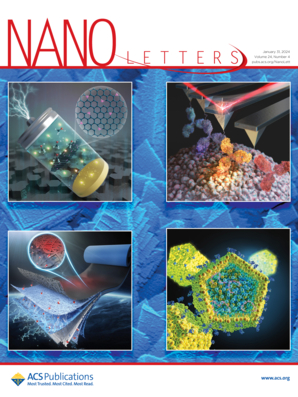SnS2 QDs@MXene Ohmic Junction-Based Surface Plasmon Coupling ECL Sensor to Detect Saliva Exosome for the Diagnosis of Childhood Asthma
IF 9.6
1区 材料科学
Q1 CHEMISTRY, MULTIDISCIPLINARY
引用次数: 0
Abstract
This study represents a novel surface plasmon coupling electrochemiluminescence (SPC-ECL) method for detecting salivary exosomes and the diagnosis of childhood asthma. First, SnS2 QDs@MXene Ohmic junctions was developed as efficient ECL emitters. The Ohmic junction provided a low resistance to reduce the contact resistance and improve charge injection efficiency, which enhanced the ECL signal by 2.76 times. Furthermore, the self-assembled surface plasmonic Bi@SiO2 array was prepared. When the ECL of SnS2 QDs@MXene resonated with the electronic oscillations in the Bi@SiO2 NPs array, the luminescence intensity was enhanced and regulated into the directionally polarized signal by the SPC-ECL effect. Remarkably, the detection of CD9-exosomes in saliva was achieved successfully based on the above sensing system, which can be used to analysis the acute exacerbation and chronic persistence of childhood asthma.

基于SnS2 QDs@MXene欧姆结的表面等离子体耦合ECL传感器检测唾液外泌体以诊断儿童哮喘
本研究提出了一种新型表面等离子体耦合电化学发光(SPC-ECL)方法,用于检测唾液外泌体和诊断儿童哮喘。首先,SnS2 QDs@MXene 欧姆结被开发为高效的 ECL 发射器。欧姆结提供了低电阻,从而降低了接触电阻,提高了电荷注入效率,使 ECL 信号增强了 2.76 倍。此外,还制备了自组装表面等离子体 Bi@SiO2 阵列。当 SnS2 QDs@MXene 的 ECL 与 Bi@SiO2 NPs 阵列中的电子振荡发生共振时,发光强度得到增强,并通过 SPC-ECL 效应调节为定向极化信号。值得注意的是,基于上述传感系统成功实现了唾液中 CD9-外泌体的检测,可用于分析儿童哮喘的急性加重和慢性持续状态。
本文章由计算机程序翻译,如有差异,请以英文原文为准。
求助全文
约1分钟内获得全文
求助全文
来源期刊

Nano Letters
工程技术-材料科学:综合
CiteScore
16.80
自引率
2.80%
发文量
1182
审稿时长
1.4 months
期刊介绍:
Nano Letters serves as a dynamic platform for promptly disseminating original results in fundamental, applied, and emerging research across all facets of nanoscience and nanotechnology. A pivotal criterion for inclusion within Nano Letters is the convergence of at least two different areas or disciplines, ensuring a rich interdisciplinary scope. The journal is dedicated to fostering exploration in diverse areas, including:
- Experimental and theoretical findings on physical, chemical, and biological phenomena at the nanoscale
- Synthesis, characterization, and processing of organic, inorganic, polymer, and hybrid nanomaterials through physical, chemical, and biological methodologies
- Modeling and simulation of synthetic, assembly, and interaction processes
- Realization of integrated nanostructures and nano-engineered devices exhibiting advanced performance
- Applications of nanoscale materials in living and environmental systems
Nano Letters is committed to advancing and showcasing groundbreaking research that intersects various domains, fostering innovation and collaboration in the ever-evolving field of nanoscience and nanotechnology.
 求助内容:
求助内容: 应助结果提醒方式:
应助结果提醒方式:


